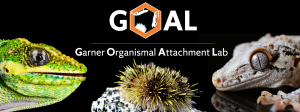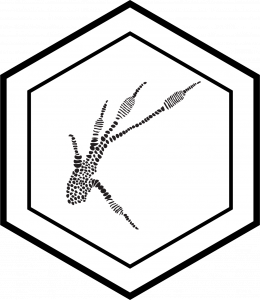Research

The Garner Organismal Attachment Lab (GOAL) is fundamentally interested in how organisms interface with their environment. We employ integrated and interdisciplinary approaches to our field and laboratory research. Our work spans the fields of functional morphology, biomechanics, anatomy, materials science, physics, chemistry, ecology, and evolution.
Our current research examines the functional morphology and biomechanics of organismal attachment using geckos, anoles, and sea urchins as model systems. We are primarily interested in how form, function, environment, and behavior interact in these systems and we use a variety of techniques in our research. We use light microscopy, electron microscopy, digital photography, x-ray radiography, histology, microCT, and geometric morphometrics to examine organismal form. We use in vivo and ex vivo measurements of performance (e.g., adhesion, friction, locomotion) to assay function in ecologically relevant and natural conditions. We investigate environmental properties (e.g., substrate roughness, wettability, hardness) using a suite of surface characterization techniques. We also examine the influence of performance and environment on organismal behavior by observing substrate/habitat use in both captive and free-ranging animals.
Click on each of the tabs below to learn more about each of our current research topic areas!
 Adhesive toe pads, composed of hair-like fibrils (setae), have independently evolved in three lineages of lizards (geckos, anoles, and skinks), but those of geckos have received the most attention. In 2019, we published a perspective that identified the toe pads of anoles, which possess a relatively simpler configuration than geckos, as an excellent model system to enhance our understanding of fibrillar adhesion. Anoles possess setae that terminate in a single adhesive tip, while those of geckos are multiply branched with many, smaller tips. Our work on the adhesive toe pads of anoles can be subdivided into three areas: (1) using Anolis as a model system to enhance our understanding of fibrillar adhesion, (2) continuing investigations establishing connections between form, function, and environment of the integrative digital anatomy of Anolis, and (3) continuing studies examining the convergent evolution of adhesive toe pads of geckos and anoles in morphological and functional frameworks.
Adhesive toe pads, composed of hair-like fibrils (setae), have independently evolved in three lineages of lizards (geckos, anoles, and skinks), but those of geckos have received the most attention. In 2019, we published a perspective that identified the toe pads of anoles, which possess a relatively simpler configuration than geckos, as an excellent model system to enhance our understanding of fibrillar adhesion. Anoles possess setae that terminate in a single adhesive tip, while those of geckos are multiply branched with many, smaller tips. Our work on the adhesive toe pads of anoles can be subdivided into three areas: (1) using Anolis as a model system to enhance our understanding of fibrillar adhesion, (2) continuing investigations establishing connections between form, function, and environment of the integrative digital anatomy of Anolis, and (3) continuing studies examining the convergent evolution of adhesive toe pads of geckos and anoles in morphological and functional frameworks.
Related Publications
Garner, A.M., M.C. Wilson, C. Wright*, A.P. Russell, P.H. Niewiarowski, A. Dhinojwala. 2022. Parameters of the adhesive setae and setal fields of the Jamaican radiation of anoles (Dactyloidae: Anolis): potential for ecomorphology at the microscopic scale. Biological Journal of the Linnean Society.
Garner, A.M., M.C. Wilson, C. Wright, A.P. Russell, P.H. Niewiarowski, and A. Dhinojwala. 2021. The same but different: setal arrays of anoles and geckos indicate alternative approaches to achieving similar adhesive effectiveness. Journal of Anatomy.
Russell, A.P. and A.M. Garner. 2022. Solutions to a Sticky Problem: Convergence of the Adhesive Systems of Geckos and Anoles (Reptilia: Squamata). In: Convergent Evolution. V. Bels and P. Legreneur (Eds).
Garner, A.M. and A.P. Russell. 2021. Revisiting the classification of squamate adhesive setae: historical, morphological, and functional perspectives. Royal Society Open Science 8: 202039.
Russell, A.P. and A.M. Garner. 2021. Setal field transects, evolutionary transitions and gecko- anole convergence provide insights into the fundamentals of form and function of the digital adhesive system of lizards. Frontiers in Mechanical Engineering 6:1-17.
Garner, A.M., M.C. Wilson, A.P. Russell, A. Dhinojwala, and P.H. Niewiarowski. 2019. Going Out on a Limb: How Investigation of the Anoline Adhesive System can Enhance our Understanding of Fibrillar Adhesion. Integrative and Comparative Biology 59(1): 61-69.
 Much of the early work examining the functional mechanisms of gecko adhesion measured adhesive performance on smooth man-made substrates, such as glass or plastic, and in laboratory conditions. Free-ranging lizards likely do not encounter such ideal conditions often, thus much of our current work investigates the influence of ecologically relevant environmental properties and conditions on gecko adhesion and locomotion. In addition to performance assays, we are interested in developing new techniques and protocols to assay the characteristics of natural and ecologically-relevant surfaces employed by lizards in the field. We are also interested in elucidating the connection between environmental properties, performance, and behavior by using behavioral assays to document habitat use in the laboratory and the field.
Much of the early work examining the functional mechanisms of gecko adhesion measured adhesive performance on smooth man-made substrates, such as glass or plastic, and in laboratory conditions. Free-ranging lizards likely do not encounter such ideal conditions often, thus much of our current work investigates the influence of ecologically relevant environmental properties and conditions on gecko adhesion and locomotion. In addition to performance assays, we are interested in developing new techniques and protocols to assay the characteristics of natural and ecologically-relevant surfaces employed by lizards in the field. We are also interested in elucidating the connection between environmental properties, performance, and behavior by using behavioral assays to document habitat use in the laboratory and the field.
Related Publications
Palecek, A.M., A.M. Garner, M.R. Klittich, A.Y. Stark, J.D. Scherger, C. Bernard*, P.H. Niewiarowski, and A. Dhinojwala. 2022. An investigation of gecko attachment on wet and rough substrates leads to the application of surface roughness power spectral density analysis. Scientific Reports 12: 11556.
Garner, A.M., A.M. Pamfilie, A. Dhinojwala, and P.H. Niewiarowski. 2021. Tokay geckos (Gekkonidae: Gekko gecko) preferentially use substrates that elicit maximal adhesive performance. Journal of Experimental Biology 224(4): jeb241240.
Garner, A.M., C. Buo, J.M. Piechowski, A.M. Pamfilie, S.R. Stefanovic, A. Dhinojwala, and P.H. Niewiarowski. 2019. Digital hyperextension has no influence on the active self-drying of gecko adhesive subdigital pads. Journal of Experimental Zoology – Part A 333(2): 118- 125.
Niewiarowski, P.H., A. Dhinojwala, and A.M. Garner. 2019. Adapting a thermal physical model approach to estimate gecko adhesion performance opportunity and constraint: How rough could it be? Integrative and Comparative Biology 59(1): 203-213.
Garner, A.M., A.Y. Stark, S.A. Thomas, and P.H. Niewiarowski. 2017. Geckos go the Distance: Water’s Effect on the Speed of Adhesive Locomotion in Geckos. Journal of Herpetology 51:240-244.
 Sea urchins are particularly unique in the organismal attachment world because they are one of the few organisms that use a glue-based adhesive to achieve strong, yet temporary attachment to the substratum. They accomplish this using a duo-gland adhesive system in their tube feet, hydrostatic projections of their water vascular system; the distal adhesive disc of tube feet excretes a glue-based adhesive to effect attachment and then secretes an enzyme to break down the adhesive to effect detachment. Sea urchins are well-known for their incredible phenotypic plasticity and their adhesive system morphology and performance is no exception to this. Our current work investigates the functional morphology and phenotypic plasticity of sea urchin tube feet in both the field and laboratory. We are particularly interested in how environmental conditions and behavior influence the plasticity of the form and function of their tube feet.
Sea urchins are particularly unique in the organismal attachment world because they are one of the few organisms that use a glue-based adhesive to achieve strong, yet temporary attachment to the substratum. They accomplish this using a duo-gland adhesive system in their tube feet, hydrostatic projections of their water vascular system; the distal adhesive disc of tube feet excretes a glue-based adhesive to effect attachment and then secretes an enzyme to break down the adhesive to effect detachment. Sea urchins are well-known for their incredible phenotypic plasticity and their adhesive system morphology and performance is no exception to this. Our current work investigates the functional morphology and phenotypic plasticity of sea urchin tube feet in both the field and laboratory. We are particularly interested in how environmental conditions and behavior influence the plasticity of the form and function of their tube feet.
Beyond researching these themes in a biological context, we are also interested in informing, improving, and assessing the design of synthetic adhesives based on natural systems (i.e., through biomimetics). Current bio-inspired synthetic adhesives are not capable of replicating all of the multifunctional properties of the biological adhesive systems, thus better understanding of the form and function of these biological systems is necessary to inform the design of the synthetic simulacra. We are interested in implementing knowledge gained from our morphological and functional investigations into synthetic adhesives to better understand the relationships between form and function in the natural and synthetic systems. We also have an interest in improving the process of biomimetics and consulting with industry or other investigators to integrate biomimetics into their R&D or research programs.
The Garner Lab is affiliated with Syracuse University’s BioInspired Institute where we actively collaborate with other SU faculty within the fields of form and function and smart materials.

